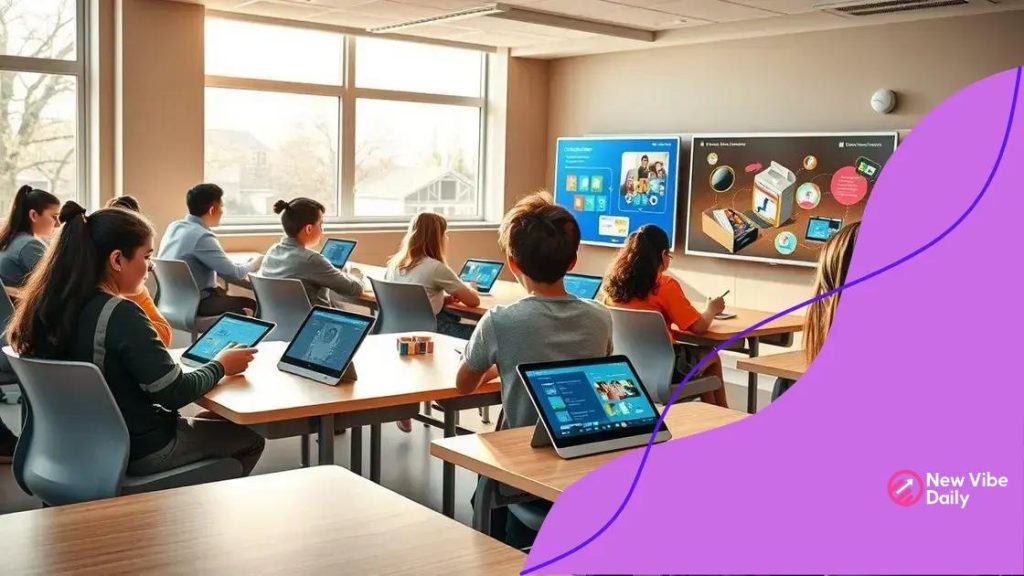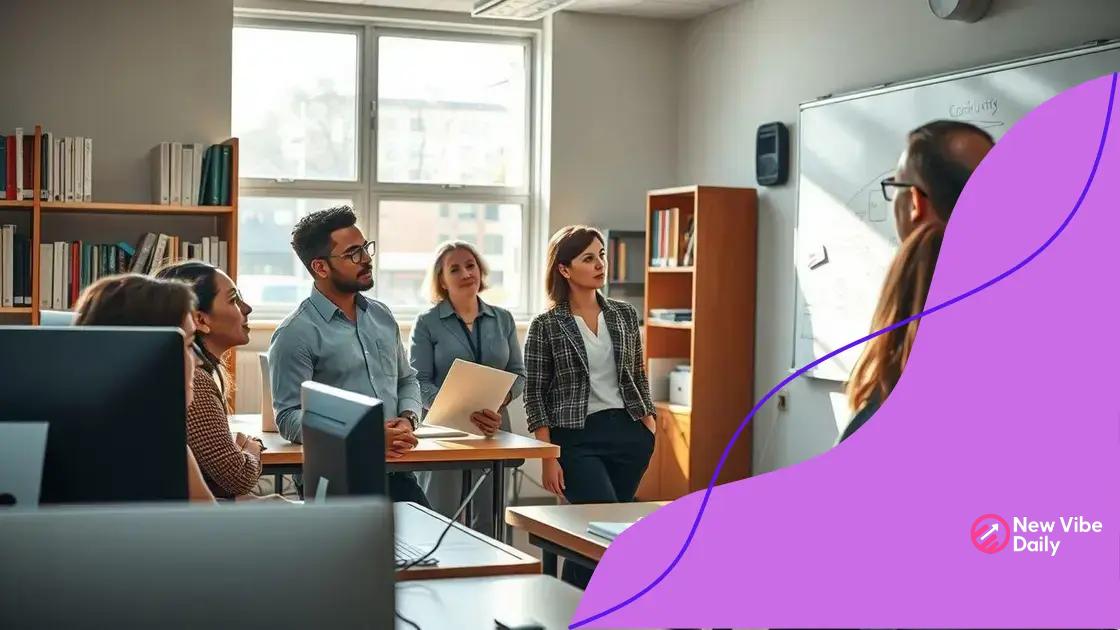Classroom technology integration: enhancing learning experiences

Classroom technology integration enhances learning by personalizing experiences, increasing engagement, and utilizing innovative tools like AI and virtual reality to prepare students for a digital future.
Classroom technology integration is changing how we teach and learn. Have you ever wondered how technology could make your classroom more engaging and effective? Let’s dive into this fascinating topic and explore its impact on education.
Understanding classroom technology integration
Understanding classroom technology integration is crucial for modern education. It involves combining digital tools and resources into the learning environment. This approach ensures students are not just passive recipients of information but active participants in their educational journey.
What is classroom technology integration?
Classroom technology integration means using various digital tools to enhance the learning process. This can include anything from smartboards to educational apps and online resources. By incorporating these tools, teachers can make lessons more interactive and engaging for students.
Benefits of integrating technology
There are several advantages of using technology in classrooms. These include:
- Enhanced engagement: Technology captivates students’ attention and makes learning more exciting.
- Personalized learning: Teachers can tailor lessons to meet individual students’ needs.
- Access to resources: Students have greater access to a wealth of information and tools.
- Collaboration: Technology fosters teamwork and communication among students.
When educators effectively integrate technology into their teaching, they unlock new opportunities for learning. For instance, using online collaboration tools can help students work together on projects, regardless of their physical location. Additionally, technology enables teachers to gather immediate feedback, improving their instructional methods.
As we explore deeper into classroom technology integration, it’s vital to consider the challenges that may arise. Some educators may feel overwhelmed by the rapid changes in technology or lack proper training on how to use these tools effectively. However, with ongoing support and professional development, teachers can overcome these barriers and thrive in a tech-rich environment.
Benefits of integrating technology in classrooms
Integrating technology into classrooms brings numerous benefits that can enhance the educational experience for both teachers and students. These advantages are not just about making lessons more enjoyable; they also improve learning outcomes and prepare students for a tech-driven world.
Increased Engagement
One major benefit of technology integration is increased engagement. When students interact with digital tools, their interest in the subject matter often rises. For example, using interactive simulations or educational games can make learning more dynamic and captivating.
Personalized Learning
Technology also allows for personalized learning. With various digital resources available, teachers can tailor lessons to meet individual students’ needs. This means students can learn at their own pace and focus on areas where they may need additional help.
- Differentiated instruction: Educators can provide different materials and activities for different learning styles.
- Feedback opportunities: Instant feedback through quizzes and assessments helps students understand their progress.
- Adaptive technologies: Tools that adjust to a student’s level can enhance comprehension.
- Self-directed learning: Students can take charge of their learning paths with online resources.
Another positive aspect of technology in classrooms is the broad access to resources. Students now have the ability to explore vast information online, diving into topics that interest them. Digital libraries, multimedia content, and online courses enrich the learning environment in ways traditional methods may not.
Collaboration is also enhanced through technology. Students can work together on projects using online platforms, sharing ideas and information in real-time. This teamwork builds essential social skills such as communication and problem-solving, which are vital for their future endeavors.
When incorporating technology, schools also influence students’ future career skills. Becoming familiar with digital tools prepares students for the modern workforce, where technology plays an integral role. Skill development in areas like critical thinking and creativity is essential in preparing them for various career paths.
Challenges faced during technology integration

Integrating technology into classrooms can be revolutionary, but it also comes with various challenges. Understanding these challenges is critical for educators to effectively navigate the integration process and ensure a positive impact on learning.
Resistance to Change
One major obstacle is often the resistance to change from teachers and administrators. Many educators may feel comfortable with traditional teaching methods and hesitant to adopt new technologies. This can lead to a lack of enthusiasm and slow down the integration process.
Lack of Training
A significant challenge is the lack of training for teachers on how to use new technology effectively. Even the most advanced tools can be underutilized if educators do not understand how to implement them in their teaching. Proper training and professional development are essential to empower teachers.
- Time constraints: Teachers often have limited time to learn new systems due to their busy schedules.
- Resource availability: Access to necessary technology tools can be inconsistent across schools.
- Support from administration: Ongoing support from school leadership is crucial for successful technology integration.
Another challenge is the issue of equity. Not all students have equal access to technology outside of school, which can create disparities in learning opportunities. Schools must address these inequalities to ensure all students benefit from technology integration.
Additionally, maintaining student engagement can be difficult when new technologies are introduced. If students do not find the technology intuitive or engaging, they may become disinterested, negating some of the potential benefits of integration.
Furthermore, concerns about data privacy and security arise with the use of online tools and platforms. Schools must ensure that students’ information is protected while navigating the digital landscape. Without proper measures, both teachers and students may be hesitant to fully engage with technology.
Effective strategies for classroom technology usage
Implementing effective strategies for classroom technology usage can significantly enhance the learning experience. By adopting well-planned approaches, teachers can ensure that technology serves as a powerful educational tool.
Set Clear Objectives
One effective strategy is to set clear objectives for using technology. Teachers should define what they want to achieve with each technology tool. This helps in focusing the lesson and providing actionable goals for students.
Incorporate Interactive Tools
Utilizing interactive tools can greatly increase student participation. Tools such as quizzes, polls, and collaborative platforms encourage students to engage actively rather than passively absorbing information. For example, using platforms like Kahoot! or Google Classroom fosters an interactive environment.
- Use multimedia: Incorporate videos, presentations, and visual aids to cater to different learning styles.
- Group projects: Encourage students to collaborate on projects using tools like shared documents or design software.
- Feedback loops: Create opportunities for students to give and receive feedback through digital means.
Another essential strategy is to provide continuous professional development for teachers. Regular training sessions allow educators to learn new technologies and share best practices. When teachers feel confident using technology, they are more likely to implement it effectively in their classrooms.
Integration should also focus on real-world applications. Connecting technology with real-life scenarios helps students understand its relevance. For instance, projects that involve data analysis or research using online databases can illustrate how technology is used in various professions.
Finally, fostering a classroom culture of innovation is crucial. Encourage students to explore and experiment with new technologies. This can create a safe space for creativity, where students feel comfortable trying new things and turning failures into learning opportunities.
Future trends in classroom technology
Future trends in classroom technology are set to shape the way students learn and teachers teach. As technology continues to evolve, classrooms will likely become even more integrated with digital tools, enhancing the educational experience.
Personalized Learning Environments
One prominent trend is the rise of personalized learning environments. Education technology will allow teachers to tailor lessons to individual student needs and learning pace. Adaptive learning platforms can modify the curriculum based on a student’s performance, ensuring they receive the support they need.
Increased Use of Artificial Intelligence
Artificial intelligence (AI) is increasingly becoming a part of education. AI can assist educators in grading, providing additional resources, and helping students with their specific learning needs. By analyzing data from student interactions, AI can suggest personalized paths for improvement.
- Smart tutors: Programs that provide additional help to students outside the classroom.
- Data analytics: Tools that help teachers track student progress more effectively.
- Voice-activated assistants: Devices that aid in classroom management and provide instant information.
Moreover, virtual and augmented reality are expected to play a significant role in future classrooms. These technologies will let students immerse themselves in different environments, enhancing their understanding of complex subjects. Imagine studying history by exploring ancient civilizations in a virtual environment or learning science through interactive 3D models.
Online collaboration tools are also evolving. As remote learning increases, tools that facilitate group projects and discussions will become even more sophisticated. Students will collaborate seamlessly, regardless of their physical locations, using shared virtual workspaces.
Another important trend is the focus on digital citizenship. As students become more reliant on technology, understanding how to navigate the digital world safely and responsibly will be essential. Schools will increasingly include lessons on digital footprint, online etiquette, and data privacy in their curriculum.
FAQ – Frequently Asked Questions about Classroom Technology Integration
What are the main benefits of integrating technology in classrooms?
Integrating technology enhances student engagement, personalizes learning experiences, and provides access to a wider range of resources.
How can teachers effectively use technology in their lessons?
Teachers can set clear objectives, incorporate interactive tools, and utilize multimedia resources to enhance their lessons.
What challenges might educators face when integrating technology?
Challenges include resistance to change, lack of training, and ensuring equitable access to technology for all students.
What future trends can we expect in classroom technology?
Future trends include personalized learning environments, increased use of AI, immersive virtual reality experiences, and a focus on digital citizenship.






